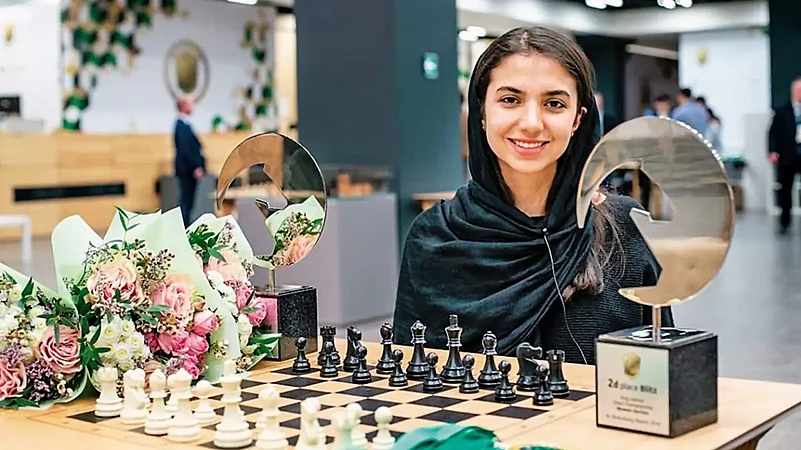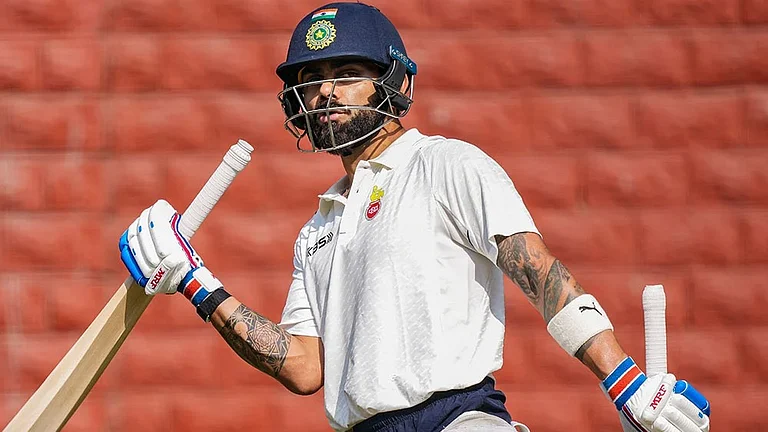As Elnaz Rekabi, the Iranian sport climber, walked out to compete at the Asian Championships in Seoul last October, she tilted her neck back and took in the wall that she would have to surmount to progress in the event. Climbing is a vertical obstacle race, with indentions and swells and no easy grips or footholds. As Rekabi, 33, gazed at the wall, one could sense she was mentally mapping out her climb.
Surely, somewhere in her mind at that moment, Rekabi must have been aware of yet another wall, albeit an invisible one, that loomed large over her and thousands of Iranian women. It was the wall of oppressive rules that women in the country had to follow, such as having to wear the hijab (headscarf). While Rekabi was competing in Seoul, throngs of Iranian women were striving to break down that wall through demonstrations. Only a month earlier, Jina Mahsa Amini, a 22-year-old Kurdish-Iranian woman, was taken into custody by Iran’s Guidance Patrol for having worn her hijab ‘improperly.’ Amini passed away in a hospital in Tehran after having allegedly been tortured by the police, resulting in a wave of protests in Iran, the largest since 2009.
Rekabi’s uniform in Seoul, therefore, turned heads because of the one thing she didn’t wear the hijab. The gesture showed choice, freedom and courage. When she scaled up that wall, she may have looked miniscule against the rock face but she was to become a giant for her countrywomen.
When Rekabi returned home after the tournament, a huge crowd gathered to welcome her at Tehran’s Imam Khomeini airport. “Champion Elnaz!” they chanted, drowning out flight-related announcements in the background. But by now, the state had reportedly swung into action and she took to Instagram to explain that her not having worn the hijab was unintentional. “Due to bad timing, and the unanticipated call for me to climb the wall, my head covering inadvertently came off,” the statement said.
Speaking to reporters at the Tehran airport, she had said, “I was unexpectedly called [for my round], and I had to compete. I was busy putting on my shoes and technical gear, and that caused me to forget putting on the hijab I had to be wearing. Then I went to compete. Fortunately, I came back to Iran with peace of mind, although I went through a lot of tension and stress. So far, thank god, nothing has happened.”

What exactly happened remains unclear. It is speculated that in Seoul, Rekabi had been taken to the Iranian embassy, where her passport and phone were confiscated. The embassy denies this.
There were also reports of her family home being demolished but a section of the media said that this predated the hijab episode and was due to a construction violation.
Despite Rekabi’s statement at the airport, many believe that she intentionally did not wear the hijab in Seoul.
“We know Elnaz decided to do this. She planned this before going to South Korea,” said Negin Shiraghaei, an Iranian activist and entrepreneur, in an interview, quoting social media posts made to similar effect by Rekabi’s close friends. “She wanted to take off her hijab as an act of resistance.”
Most Iranian athletes who are critical of the regime move to other countries. But Rekabi was brave enough to return to Iran, as Shiraghaei pointed out. “This is a rare case that someone dared to do something like this, and went back to the country and faced the consequences,” she said.
In the days following the controversy, there was concern about Rekabi’s whereabouts. But in a March 21 photo on Instagram, she can be seen in a crowd, wearing a black baseball cap, with the post saying, “Happy Iranian New Year. With the best wishes for my people, Iran.
The latest development on Rekabi’s situation is that she was allegedly stopped from leaving Iran for Spain for training last week. However, she is in contention to participate in the 2024 Paris Olympics.
Stifling rules and the state machinery’s high-handed, often brutal, treatment of dissenters has outraged many an Iranian athlete. Prominent chess players, for example, have defected to other countries. Mitra Hejazipour and Ghazal Hakimifard now represent France and Switzerland, respectively. Atousa Pourkashiyan and Dorsa Derakhshani compete under the US flag. The most recent chess player to get fed up of the claustrophobic conditions for women in Iran is the high-profile International Master Sara Khadem.
Last December, Khadem refused to wear the hijab at the FIDE World Rapid and Blitz Championships in Almaty, Kazakhstan. Knowing what awaited her at home, she moved to Spain with her young son and her husband, film director Ardeshir Ahmadi. Khadem, 26, had made several trips to Spain as a player and felt comfortable there.
Khadem was not always one to voice her political views in public but the dam had burst in 2020. Alireza Firouzja, the men’s chess prodigy from Iran who became a Grandmaster at 14, moved to France after authorities allegedly forced him to lose each time he played against a player from Israel. Khadem then recorded a message of support on video for Firouzja. She also withdrew from the national team in protest after the Iranian Armed Forces’ Islamic Revolutionary Guard Corps (IRGC) shot down a Ukrainian International Airlines plane, mistaking it for an American cruise missile. There were 176 passengers and crew on board, none of whom survived.
Khadem’s passport was withdrawn for six months as a penalty for her pull-out. Then came the tipping point. Popular Iranian actress Taraneh Alidoosti was arrested in December last year for a post on Instagram, in which she appeared without a hijab, holding a sign that said “Woman, Life, Freedom” in Kurdish.
In a recent interview with the BBC, Khadem said, “In Iran, whatever you do is political. What I did now (played chess without a headscarf) would not be considered political in any other country but Iran.”
Khadem may no longer be in her homeland. But at least she is alive. And as long as you are alive, you can fight. “I want to think that one day everything will change,” Khadem said. “It (the protests) started because of the women, but some men are fighting with us too. There are many of us who are in this together.”
(This appeared in the print as "Politics At Play")

























